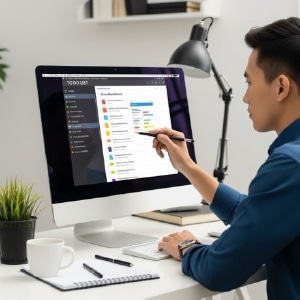As a physician, I often encounter patients seeking practical advice for managing various health conditions in their daily lives. Today, I want to talk about Attention-Deficit/Hyperactivity Disorder (ADHD) and, specifically, how individuals with ADHD can thrive in their professional environments.
ADHD symptoms like difficulty focusing, impulsivity, and restlessness can present unique challenges at work. However, with the right strategies and accommodations, it’s absolutely possible to not only manage these symptoms but also leverage the strengths that often come with ADHD, such as creativity and hyperfocus on engaging tasks.
Here are my top 5 tips to help you navigate your career successfully:

1. Optimize Your Workspace
Your environment plays a significant role in your ability to concentrate. Consider setting up your workspace in a way that minimizes distractions. This might mean:
- Decluttering: A tidy desk can lead to a tidier mind. Get rid of unnecessary papers and items.
- Noise Control: If possible, choose a quiet area. If not, consider investing in noise-canceling headphones.
- Personalization: Make your space comfortable and conducive to your work style, but avoid over-cluttering it.

2. Prioritize and Break Down Tasks
One of the biggest challenges for individuals with ADHD is getting started on large or overwhelming tasks. Break down your projects into smaller, manageable steps. This makes them seem less daunting and provides a clearer path forward.
- To-Do Lists: Create daily to-do lists and prioritize tasks using methods like urgent/important matrices.
- Time Blocking: Allocate specific blocks of time for different tasks on your calendar.
- The Pomodoro Technique: Try working in focused bursts (e.g., 25 minutes) followed by short breaks (5 minutes).

3. Take Regular Breaks
It might seem counterintuitive, but taking short, frequent breaks can actually improve your productivity. For individuals with ADHD, these breaks can help reset your focus and prevent mental fatigue.
- Move Around: Stand up, stretch, or take a short walk away from your desk.
- Mindful Moments: Practice a brief mindfulness exercise or deep breathing to calm your mind.
- Hydrate and Fuel: Drink water and have a healthy snack to keep your energy levels stable.

4. Utilize Technology Wisely
Technology can be a double-edged sword for those with ADHD – a source of distraction but also a powerful tool for organization and focus.
- Reminders and Alarms: Use your phone or computer to set reminders for tasks, meetings, and breaks.
- Focus Apps: Explore apps designed to block distracting websites or create a timed focus environment.
- Digital Planners: Many digital tools can help you organize tasks, notes, and deadlines across devices.
5. Communicate and Advocate for Yourself
Open communication with your employer and colleagues can make a significant difference. You don’t necessarily need to disclose your diagnosis, but you can discuss your work style and what helps you perform best.
- Discuss Preferences: Explain that you work best with clear instructions or in a quiet environment.
- Request Accommodations: If needed, explore reasonable accommodations under relevant disability laws (e.g., a private office, flexible hours).
- Seek Support: Don’t hesitate to reach out to HR or a supervisor if you need support or resources.
Managing ADHD at work is an ongoing process of learning what works best for you. Be patient with yourself, experiment with different strategies, and remember that seeking professional guidance from a doctor or therapist specializing in ADHD can provide invaluable personalized support. Your unique brain wiring brings valuable perspectives and strengths to the workplace – embrace them!


